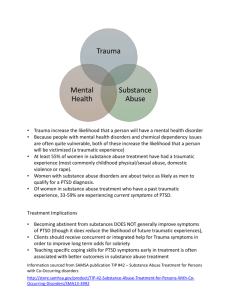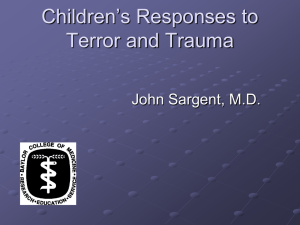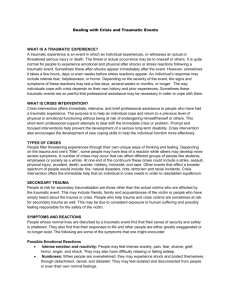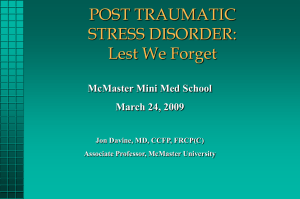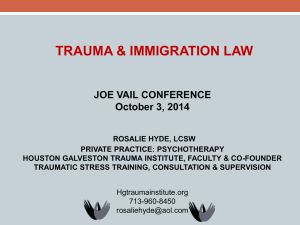Post Traumatic Stress Disorder
advertisement
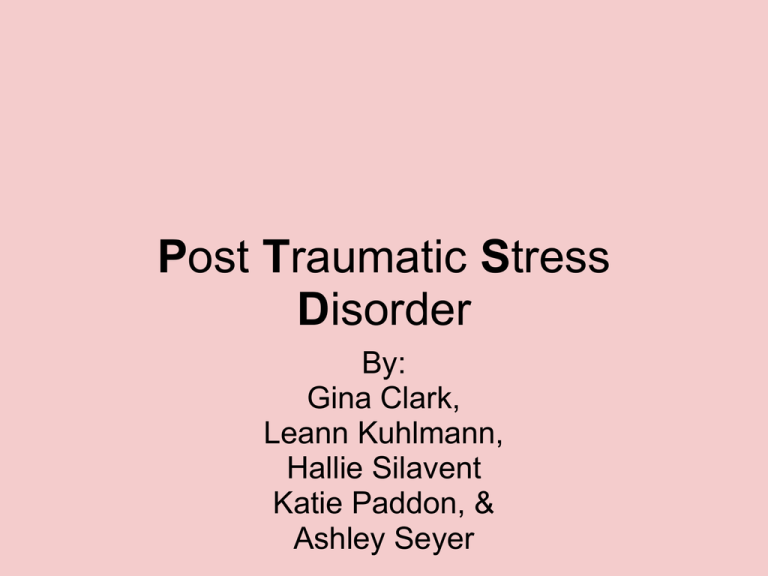
Post Traumatic Stress Disorder By: Gina Clark, Leann Kuhlmann, Hallie Silavent Katie Paddon, & Ashley Seyer What is PTSD? - a broad category that applies to people who have been severely thraumatized at one or more times in their life -at present, they are not functioning effectively because they have not integrated the trauma and laid it to rest. -PTSD is threathening to oneself and their loved ones PTSD on the DSM 1.) The person has been exposed to a traumatic event in which both of the following were present: - The person experienced, witnessed, or was confronted with an event(s) that involved a.) actual or threatened death or serious injury b.) or a threat to the physical integrity of self or others -The person's response involved intense fear, helplessness, or horror. DSM continued... 2.) The traumatic event is persistently reexperienced in one or more of the following ways: - recurrent & intrusive distressing recollections of the event (includes images, thoughts, perceptions) - recurrent distressing dreams of the event -Acting or feelings as if the traumatic event were recurring (illusions, hallucinations, flashbacks, etc.) - Intense psychological distress at exposure to internal/external cues that symbolize/resemble an aspect of the traumatic event - Physiological reactivity of an aspect of the traumatic event 3.) Persistent avoidance of stimuli associated with the trauma & numbing of general reponsiveness (3 or more of the following) -efforts to aviod thoughts, feelings, convos associated with the trauma -efforts to aviod activities, places, or people that arouse the recollection of the trauma -inability to recall an important aspect of the trauma -markedly diminished interest/participation in significant activities -feelings of detachment/estrangement from others -restricted range of affects (inability to feel love, trust...) -sence of foreshortened future (can't see life w/o job, normal relationship, ever having kids, normal life, etc...) 4.) Persistent symptoms of increased arousal as indicated by two or more of the following: -difficulty falling or staying asleep -irritability or outbursts of anger -difficulty concentrating -hypervigilance -exaggerated startle response 5.) Duration of the disturbance (symptoms in criteria 2-4) for 1 month or longer 6.) The disturbance causes clinically significant distress or impairment in social, occupational, or other important areas of functioning. Acute Stress Disorder -A psychological condition arising in response to a terrifying event. (aka: psychological shock) -Results from physical/mental stress, fear, or pain in accordance with/from PTSD, usually subsides within a few hours or even days -symptoms include: initial state of "daze", inability to comprehend imformation, low attention, & agitation. DSM criteria for Acute Stress Disorder 1.) The person has been exposed to a traumatic event in which both of the following were present: - The person experienced, witnessed, or was confronted with an event(s) that involved a.) actual or threatened death or serious injury b.) or a threat to the physical integrity of self or others -The person's response involved intense fear, helplessness, or horror. 2.) Either while exeriencing or after experiencing a distressing event, the indivual has 3 (or more) of the following: a.)a subjective sense of numbing, detachment, or absence of emotional responsiveness b.) a reduction in awareness of his/her surroundings c.)derealization d.)depersonalization e.)dissociative amnesia(unable to recall important aspects of trauma) 3.) Traumatic event is persistently re-experienced in at least 1 of the following way: recurrent dreams, images, thoughts, flashbacks, ect. Reminding them of the traumatic event. 4.) Marked avoidance of stimuli that arouse recollecgtions of the trauma (thoughts, feelings, convos, places, people, etc) 5.)Marked symptoms of anxiety or increased arousal(difficulty sleeping, poor concentraction, hypervigilance, motor restlessness, etc...) 6.) The disturbance causes clinically sigificant distress or impairment in social, occupational, or other important areas of functioning. Or impairs the individual's ability to persue some necessary tasks, obtaining necessary assistance, or mobilizing personal resources (telling family members about the trauma) 7.) The disturbance lasts for a minimum of 2 days & a maximum of 4 weeks and occurs within 4 weeks after traumatic event. 8.) The disturbance is not due to the direct phsiological effect of a substance (drug abuse, or medication) or a general medical condition Serving in Combat or Living in a War Zone • Counselors first became aware of PTSD dealing with war veterans • Average person dealing with PTSD (in the military) • Possible symptoms • Shell Shock • The difference between WWII veterans and Vietnam Veterans • Acute stress disorder in the military & Persian Gulf Syndrom Suffering Personal or Family Victimization • People are often victimized by others who intend to kill, harm, or itimidate, or all three • Sexual abuse survivors constitue the largest number of PTSD victims • Many perpetrators of this type of victimization know their victims personally • Trust issues Types of trauma that may lead to PTSD • witnessing a loved one being murdered • witnessing or being part of a gruesome car accident • being kidnapped or being the parent of a child who is abducted • having personal property vandalized • having ones home burglarized • being robbed at gunpoint PTSD for survivors of these types of trauma may be severe or mild,depending on the perceived level of threat. They often suffer from feelings of paranoia, hypervigilance, and powerlessness. They are usually angry and fearful. Natural and Manmade Disasters Life After Diaster: Concepts • Material Resources • Perception o Blame o Subjective Distress • Danger and Opportunity Phases Heroic Honeymoon Disillusionment Reconstruction EFFECTS ON YOUNG CHILDREN Effects on young children (similar behavior to an abused child) • returning to earlier behavior (thumb sucking or bed wetting) • clinging to parents • being reluctant to go to bed • nightmares • fantasies that the disaster or incident never happened • screaming and crying • withdrawal and becoming immobile • refusing to attend school • problems at school • unable to concentrate What can cause PTSD in children: • survival of natural or manmade disaster (flood) • violent crime (kidnapping, rape or murder of parent, school shooting) • car or plane crash • severe burns • war • sexual and physical abuse • peer suicide • exposure to violence in community PTSD effects on children Very young children • may show only a few symptoms because eight of the symptoms require speech • instead may show separation anxiety, avoid situations that may or may not relate to the trauma, trouble sleeping, repeat trauma during play, regress by losing an acquired skill such as potty training PTSD effects on children Elementary school-aged children • may not experience flashbacks as adults do • do experience time skew and omen formation, which is not seen in adults • time skew- mis-sequencing events when recalling the memory of the trauma • omen formation- belief that there were warning signs predicting the trauma • reenact trauma during play or in drawings The Debriefing Process Debriefing- intervention after a person has been assessed to be affected by a critical incident; includes listening, empathizing, educating, and supporting • Traumatized people should be encouraged to function where possible and maintain healthy eating habits and sleep patterns • Should attend community support groups, talking with others who have shared the same trauma is beneficial Interventions When disaster happens: • They affect not only those directly involved but others who suddenly feel that their security is threatened. • Communites respond by providing support. Examples of community suppport include: • Red Cross • Elementary schools • public parks • local church organizations The Importance of the crisis worker o Crisis workers need to help people to think differently about the crisis situation o The worker helps those experiencing overwhelming feelings to focus those feelings into productive avenues for growth Critical Incident & Debriefing Trama Response • Special training programs developed for workers wanting to help victims of disasters through the Red Cross and other organizations such as the International Medical Corps. • A Crisis intervention method that stabilizes, supports and normalizes peoples efforts to strengthen coping abilities • Prevent long-term damage such as PTSD, substance abuse, depression, and family & relationship problems. • Not meant to be used as a "treatment" Symptoms of PTSD Physical symptoms include: fatigue, nausea, muscle tremors, twitches, chest pain, difficulty breathing, elevated blood pressure, rapid heart rate, thirst, visual difficulties, vomiting, grinding of teeth, weakness, dizziness, profuse sweating, chills shock symptoms, and fainting. Emotional and behavioral symptoms include: anxiety, guilt, grief, panic,fear, uncertainty, loss of emotional control, depression, irritability, apprehension,change in activity, change in speech patterns, withdrawal, outbursts, suspiciousness, loss or increase of appetite, alcohol consumption, etc. Symptoms of PTSD continued: Cognitive symptoms include: blaming, confusion, poor attention, poor decisions, poor concentration, memory problems, increased or decreased awareness of surroundings, poor abstract thinking, loss of time, place, or person, nightmares, and intrusive images.
